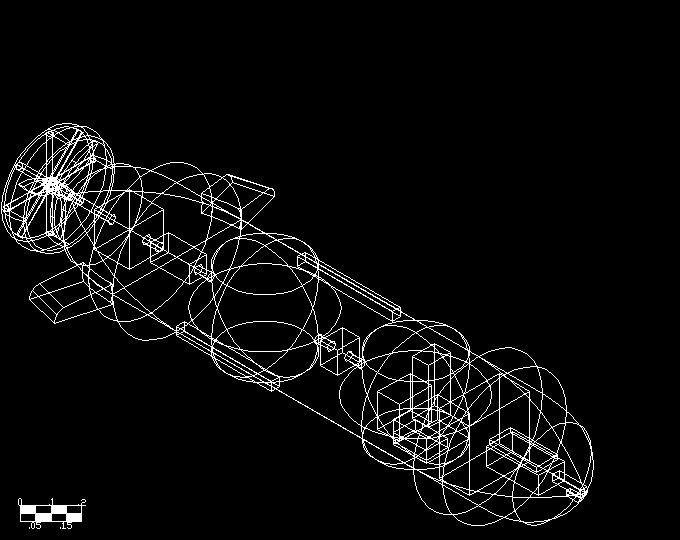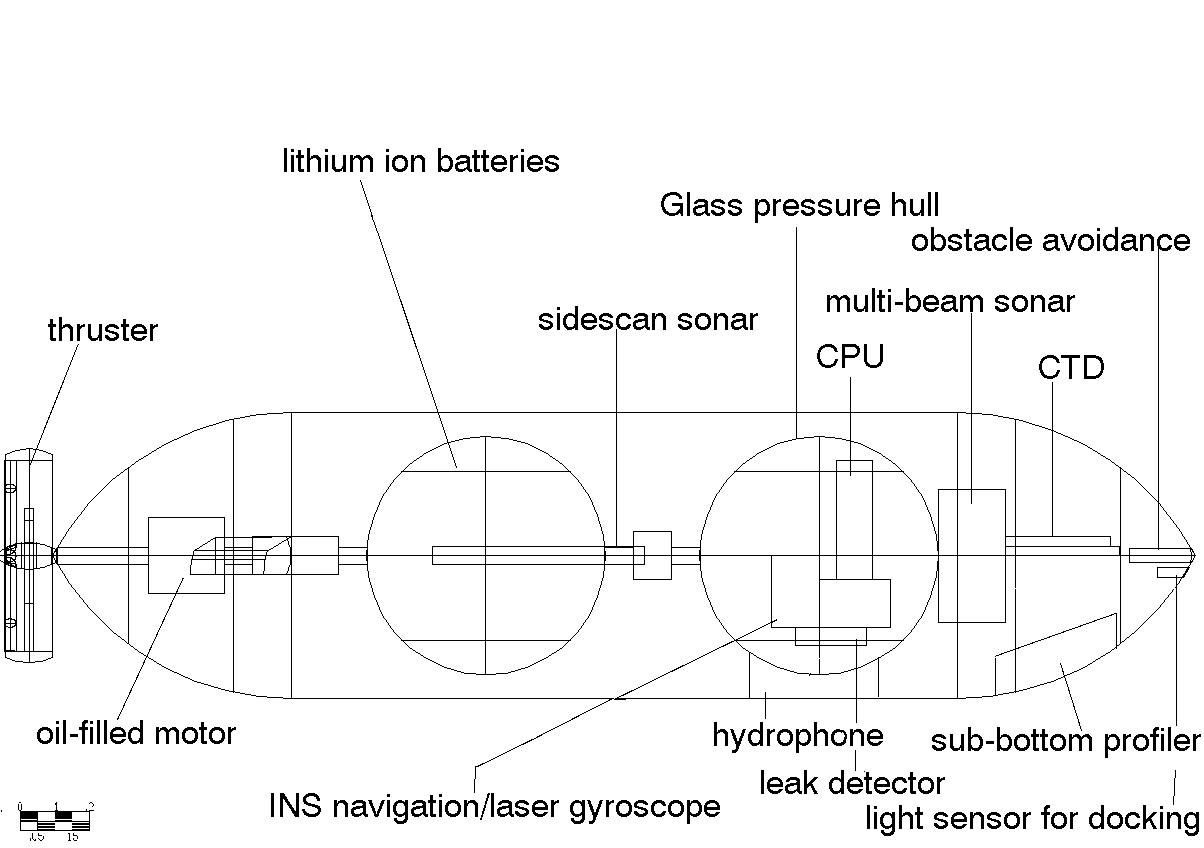
The Three Sisters AUVs
The Three Sisters, Calypso, Medusa, and Aveta are three Autonomous Underwater Vehicles (AUVs) that can work together to collect distribution data. The idea of having several autonomous robots collaborating on a single task is considered highly efficient. In the long run, less power is consumed in using a fleet of mapping AUVs as opposed to a single vehicle. Also, if a vehicle were to malfunction the mission is not severely jeopardized. With the advent of more sophisticated artificial intelligence, the AUVs would be capable of "teamwork." They are identical in structure, and payload.
Capable of mapping the bottom, the Sisters will also construct graphical arrays of temperature, salinity, vertical velocity (vents), and horizontal velocity ( currents). They would be equipped with several sonars for mapping and other relevant sensors.
To transfer their collected data, they would be enabled with acoustic modems (see navigation) to transmit data to the habitat, but also be capable of storing data on an on board computer considering the acoustic modem probably won't be able to transfer the bulk of its data collection in real time. When they come back to the habitat, they will be equipped with an extension (see tools) that can transfer data to the lab computers. The extension will also enable the vehicles to recharge their batteries. The idea is to rely on external docking for most functions. In the case when the rechargeable batteries finally need to be replaced, or for repairs, the habitat has provided a docking sphere. However, internal docking is not an easy process (see docking).
Technical Specifications
Each of the musketeers has the same design. They have a torpedo shape to minimize drag and simultaneously allows them to be modified with time. They are freely flooded, except two pressure hulls, wrought of glass that house the batteries, navigation unit, CPU, and dry end of sensor electronics. The outer faring is made of ABS plastic.(see structure)It does not provide any structural support, but optimizes hydrodynamic efficiency.
Length: 220 cm
Maximum Diameter: 60 cm
Max depth rating: 4000 m

Click to see full sized schematic of above 3D Three Sister design

Click to see full sized schematic of above labeled Three Sister schematic
Payload Sensors
- Sidescan sonar(Klein Technologies)
- multi-beam sonar
- CTD(seabird electronics)
- sub-bottom profiler
- acoustic doppler current profiler and velocity logArgonaut-dvl from Sontek
- leak detector
- obstacle avoidance sonar
For information on what the sensors are used for see Sensors
Navigation unit
Acoustic modemInertial Navigation System
laser gyrometer
acoustic equipment for lbl navigation
Pressure hull
2 * 50 cm diameter glass spheres, 1.5 cm thick. They house the dry components under atmospheric conditions and provide buoyancy for the vehicle. The CPU is in the PC104 format, allowing interchangeability and upgradeability of components. PC104 also allows operation of the AUV in the familiar C programming language.Energy
The AUVs will use lithium ion. Lithium ion is useful here because it can last for up to 7 days without recharging. This is essential, as the Sisters will be operating for long stretches at a time. Lithium ion can be recharged from within the pressure hull, without much danger to the vehicle. Eventually, we would hope to use fuel cells for the battery source. They provide the greatest energy density, and output power, but are currently underdeveloped.Propulsion
A single DC, brushless, oil compensated motor powering a single thruster at the stern of the vehicle. Two hydroplanes to add necessary stability to the vehicle, while it accurately maps the terrain.Buoyancy and Power calculations
Power
The power consumption of the various sensors on board the AUV:(Hotel Load)- CTD - 5 W
- Sidescan sonar - 8W
- Multi-beam sonar - 10W
- Acoustic Doppler Velocity Log - 3W
- Obstacle avoidance - 4W
- Navigation Systems - 5W
- Electronic components and Intel 80186 CPU (navigation computer available from Sonardyne):- 1 -3W
- Actuators = 5 W
Total power consumption of sensors and CPU is approximately = 43 watts
The power of propellers is given by equation: 0.5 * p * A * v^3 * coefficient of drag
(Provided that the AUV is moving with constant velocity)
Coefficient of drag = 0.15
Now range = v * t
Total energy = (Peq + 0.5 * A * p * v^3 * C) * t
Substituting for t from equation (2) we get:
range = Etotal v/ ( Peq + 0.5 *A * p * v^3 * C)
Using differentiation, max range occurs when v = (P/(A * p * Cd))^3
Area = 0.28 meters squared, p = 1 035 kg/m^3
Therefore, optimum velocity = 0.996 approximately 1 m/s = 2 knots
These equations are approximate, and do not take into account the variation in density of the water with position, and the variable cross-sectional area of the vehicle. From research, and on advice of experts in the field an optimum velocity for the vehicle would be about 1.5 m/s.
Energy density of lithium ion batteries = 250 Wh/l
Total energy = 9.5 kwh
Therefore, range ( from equation 3) = 441 km (ideal range.)
Propulsion Load:
Power = 0.5 * p * v^3 * Cd * A = 73.3 Watts (assuming they are 100 % efficient, which of course is not the case.)
Buoyancy calculations
| Instrument | Weight in Air(kg) | Weight in water |
|---|---|---|
| CTD | 2.7 | 1.4 |
| Sidescan | 1.5 | 0.6 |
| multi-beam | 4 | 1.25 |
| Spheres | 25 | -44 |
| Sub-bottom | 4 | 2.25 |
| ADCP | 9.1 | 2.7 |
| Modem | 11.1 | 3.95 |
| Thruster | 2.7 | 2 |
| Batteries | 74 | 74 |
| Navigation and electronics | 1.2 | 1.2 |
Therefore = total weight in air = 160.3 kg
Total weight in water = 1.35 kg. Therefore buoyancy is -1.35kg
We want our vehicles to be neutrally buoyant in water, therefore weight should be 0 kg. We will use syntactic foam to provide the positive 1.3
Emergency Measures
Each AUV has a strobe that flashes in case of emergency, and allows the AUV to be visible to any rescue vehicles that search for it.The leak detector acts as a preventative device. If the hull is leaking, it emits a warning, and disables the propulsion systems so the AUV cannot launch.
The AUV is designed to be slighty negatively buoyant so that if it should stop working it will sink to the bottom, where it can be picked up by rescue vehicles.
In the unlikely event the vehicle is lost, or its navigation sonars cease to function, it emits a distinctive sonar signal, that will allow it to be located. It also emits an emergency signal via its acoustic modem.
The Sisters will be tracked acoustically. An acoustic signal will be sent out form the habitat to pinpoint the exact location of the Sisters at any given time. This is essential in preventing the loss of the AUVs to sea.
Resources
1. Three Graces Image: http://ccimg.catalogcity.com/190000/193600/193639/Products/6032-mdm.jpg2. Three Sisters 3D Diagram designed by Armando Valdes
3. Three Sisters Schematic designed by student Armando Valdes, labelled by Adam Cornelius.

